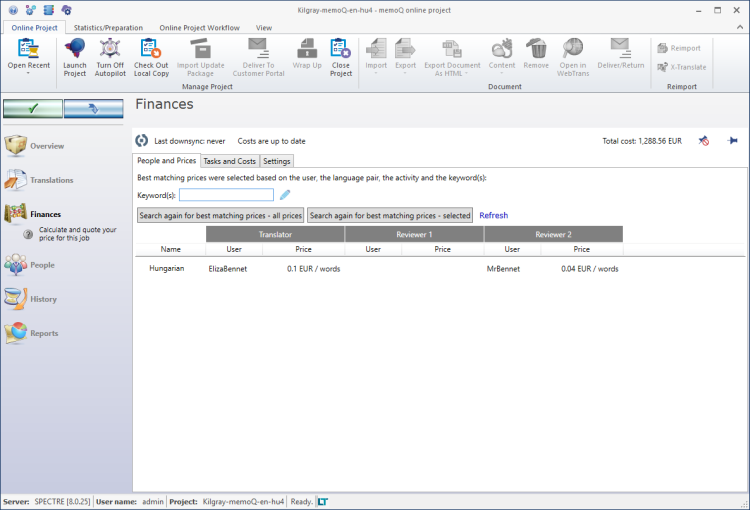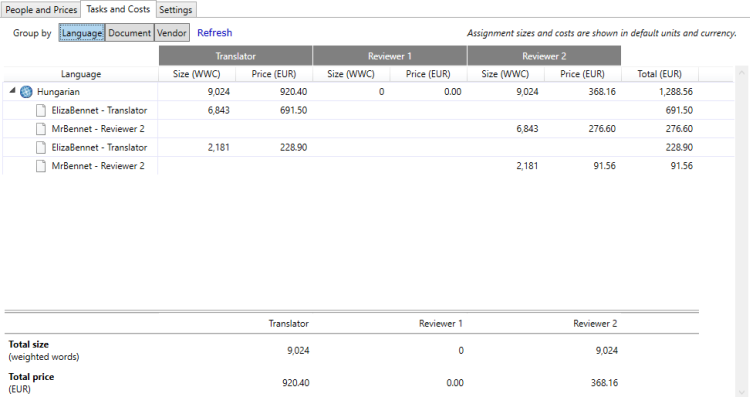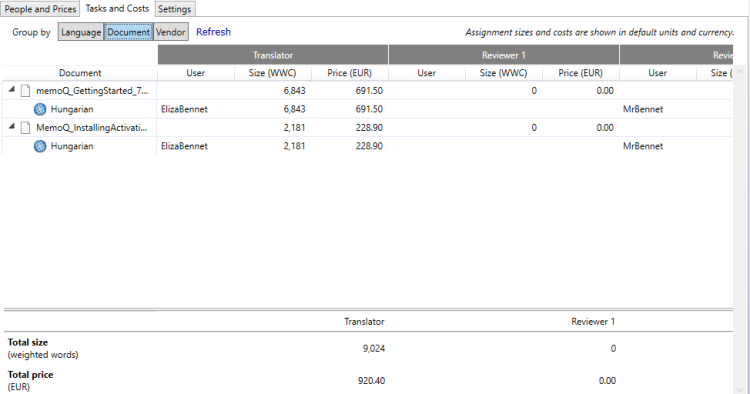memoQ online project - Finances
Project must be connected to Language Terminal: The Finances pane does not appear if the project is not connected to Language Terminal. You can connect an online project to Language Terminal when you create it. Before you connect a project to Language Terminal, you must connect your memoQ server itself to Language Terminal.
In the Finances pane of the memoQ online project window, you can check the costs of your project. The Finances pane will automatically show the costs after:
- Participants of the project are listed in the organization's Language Terminal profile as internal vendors, and
- Prices - pricing strategies - are added to the organization's Language Terminal profile, and
- At least one analysis report was prepared in the project (in template-based projects, this usually happens automatically), and
- Users are already assigned to documents (to one document at least, to be precise).
If not all participants are on Language Terminal as internal vendors, or not all documents are assigned, memoQ will show partial costs.
The Finances pane shows the prices for each participant; the total cost for each task, language, and participant (you can choose the breakdown), and you can change the Language Terminal settings for the project.
Requires memoQ project manager: You need the project manager edition of memoQ to manage online projects.
You need to be a project manager or an administrator: You may manage online projects only if you are a member of the Project managers or Administrators group on the memoQ server – or if you have the Project manager role in the project.
How to get here
First, open an online project for management:
- On the project management dashboard, find the project you need to manage. Search for the project if needed.
- Click the name of the project.
- On the Project ribbon, click Manage. A new memoQ online project window opens. In most cases, the Translations pane appears automatically.
- On the left, click the Finances icon. The Finances pane appears.

What can you do?
On the People and Prices tab, memoQ lists the participants for each target language and for each role.
For each participant, the table shows the price that memoQ server uses.
- To learn more about a pricing strategy, click the price. The Change pricing strategy window opens.
- In the Change pricing strategy window, you can choose another pricing strategy for that person. You must choose from the pricing strategies that are already listed on Language Terminal for your organization.
You can also change how memoQ selects a pricing strategy for each participants. There are two things you can do:
- At the top of the list, in the Keyword(s) box, you can type a word or two. memoQ will prioritize pricing strategies that have these words in their descriptions. For example, you can have special prices for legal translation; then, on Language Terminal, you write the word 'legal' in the descriptions of those pricing strategies. Now, you type the word 'legal' in the Keyword(s) box, then click Search again for best matching prices - all prices. memoQ will re-evaluate the pricing strategies, and update the prices in the table.
- You can change pricing strategies on Language Terminal. You can add or remove those, or change existing ones. To do this, visit the Pricing strategies page of your organization's Language Terminal profile. Make changes to the pricing strategies. Then return to memoQ, and click Search again for best matching prices - all prices.
You can search for new pricing strategies for selected users only - for example, when you need new prices for Reviewer 2 users.
- Select the users in the table: Click the name of the first user. Press and hold down Ctrl, and then click the names of the other users.
- At the top, click Search again for best matching prices - selected.
If the project changes - new documents are added, or the assignments changed -, run an analysis report (if it is not run automatically). Then return to the Finances pane, and click Refresh. memoQ will recalculate the costs with the existing pricing strategies, but with the updated project contents.
To see the costs of the project, click the Tasks and Costs tab.
memoQ will show the costs, at first by language.

To see the costs grouped by document: At the top, click Document:

To see the costs by participant: At the top, click Vendor:

Caution, the costs are not always up to date: If you do not see the text Costs are up to date at the top, you may need to refresh the tables. First, run an analysis report on the project. Then return to the Finances pane. If the pricing strategies changed: On the People and Prices tab, click Search again for best matching prices - all prices. Finally, on the People and Prices tab or on the Tasks and Costs tab, click Refresh.
This is where you can change the deadlines, the cost calculation methods, and the time logging methods of the project.
This page is the same as the Language Terminal settings page when you create a new online project (in the Create new project from template window or in the New memoQ project wizard).
- Set the start date and the overall deadline for the project. Choose two dates in the Project start and in the Project deadline boxes.
- memoQ can calculate the costs of the project. Your profile may contain several pricing strategies, which can be used for calculating the cost of translation or reviewing, and it can depend on the language pair, the vendor, and on keywords that are there in the description of the pricing strategy. You can use the keywords to categorize the pricing strategies, and on the Project information page, you can type keywords to choose the right pricing strategies.
To view and change pricing strategies: Visit the Pricing strategies page of your Language Terminal profile.
- Choose how memoQ should calculate the costs. Before the documents are translated, all you have is the analysis. Those numbers must be multiplied with the prices in the pricing strategies. However, after the documents are translated, you can use the post-translation analysis. The post-translation analysis tells you what matches have actually been used, rather than what matches could be used (that's what the analysis says). Normally, memoQ will use the post-translation analysis. If you need to use the analysis all along, click the Always Statistics radio button.
- Choose how hours should be calculated. Sometimes reviewing is paid by the hour. (It happens in translation, too, but it is not as common.) To calculate the cost, memoQ must be able to count the hours. memoQ will calculate the hours from the word count, but participants can also log time in the project. Normally, memoQ allows everyone to do this. If you want to restrict this to in-house translators and reviewers, click the Allow logging for in-house vendors radio button. To prevent people from logging time at all, click the Don't allow logging radio button.
When you finish
To make changes to the documents, resources, or settings or the project, or to see reports, choose another pane:
- Overview
- Translations
- Finances (the project must be connected to Language Terminal)
- People
- Packages (only in package-based online projects)
- LiveDocs
- Translation memories
- Term bases
- Muses
- Settings
- History
- Reports
- Files
Or, to return to Project home or to the Dashboard: Close the memoQ online project window. Before that, make sure you save your changes.
When you make changes to an online project, the changes will happen on memoQ server, not on your computer. It is possible that several users make changes to the project at the same time.
Some changes are not saved automatically. When there are changes you need to save, the green tick mark icon at the top left will become orange:
![]()
To save changes to the online project, click this button.
To get the changes that others made to the online project, click this button:
![]()
Make sure you save your changes before you click this.
Switch windows: You can open several online projects for management. Each online project opens in a separate window. To switch between them and the Dashboard or Project home (if you have a local project open): press and hold down Alt, and press Tab a few times until you get to the window you want. Or: On the Windows taskbar, click the memoQ icon, and then click the window you want to switch to.